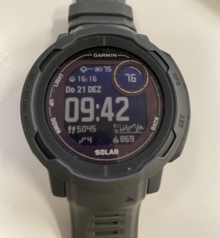
A wearable computer, also known as a body-borne computer, is a computing device worn on the body. The definition of 'wearable computer' may be narrow or broad, extending to smartphones or even ordinary wristwatches.

A pedometer, or step-counter, is a device, usually portable and electronic or electromechanical, that counts each step a person takes by detecting the motion of the person's hands or hips. Because the distance of each person's step varies, an informal calibration, performed by the user, is required if presentation of the distance covered in a unit of length is desired, though there are now pedometers that use electronics and software to determine how a person's step varies automatically. Distance traveled can be measured directly by a GPS receiver.
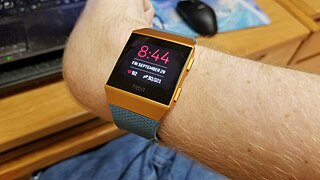
A heart rate monitor (HRM) is a personal monitoring device that allows one to measure/display heart rate in real time or record the heart rate for later study. It is largely used to gather heart rate data while performing various types of physical exercise. Measuring electrical heart information is referred to as electrocardiography.
eHealth describes healthcare services which are supported by digital processes, communication or technology such as electronic prescribing, Telehealth, or Electronic Health Records (EHRs). The use of electronic processes in healthcare dated back to at least the 1990s. Usage of the term varies as it covers not just "Internet medicine" as it was conceived during that time, but also "virtually everything related to computers and medicine". A study in 2005 found 51 unique definitions. Some argue that it is interchangeable with health informatics with a broad definition covering electronic/digital processes in health while others use it in the narrower sense of healthcare practice using the Internet. It can also include health applications and links on mobile phones, referred to as mHealth or m-Health. Key components of eHealth include electronic health records (EHRs), telemedicine, health information exchange, mobile health applications, wearable devices, and online health information. These technologies enable healthcare providers, patients, and other stakeholders to access, manage, and exchange health information more effectively, leading to improved communication, decision-making, and overall healthcare outcomes.
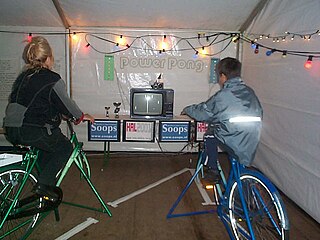
Fitness game, exergame, and gamercise are terms used for video games that are also a form of exercise. Fitness games rely on technology that tracks body movement or reaction. The genre has been used to challenge the stereotype of gaming as a sedentary activity, and promoting an active lifestyle among gamers. Fitness games are seen as evolving from technology aimed at making exercise more fun.
Protected health information (PHI) under U.S. law is any information about health status, provision of health care, or payment for health care that is created or collected by a Covered Entity, and can be linked to a specific individual. This is interpreted rather broadly and includes any part of a patient's medical record or payment history.
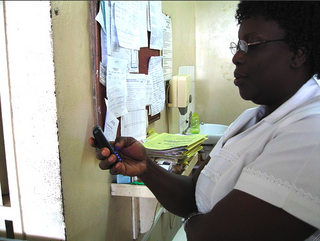
mHealth is an abbreviation for mobile health, a term used for the practice of medicine and public health supported by mobile devices. The term is most commonly used in reference to using mobile communication devices, such as mobile phones, tablet computers and personal digital assistants (PDAs), and wearable devices such as smart watches, for health services, information, and data collection. The mHealth field has emerged as a sub-segment of eHealth, the use of information and communication technology (ICT), such as computers, mobile phones, communications satellite, patient monitors, etc., for health services and information. mHealth applications include the use of mobile devices in collecting community and clinical health data, delivery/sharing of healthcare information for practitioners, researchers and patients, real-time monitoring of patient vital signs, the direct provision of care as well as training and collaboration of health workers.
Fitbit is a line of wireless-enabled wearable technology, physical fitness monitors and activity trackers such as smartwatches, pedometers and monitors for heart rate, quality of sleep, and stairs climbed as well as related software. It operated as an American consumer electronics and fitness company from 2007 to 2021.

Wearable technology is any technology that is designed to be used while worn. Common types of wearable technology include smartwatches and smartglasses. Wearable electronic devices are often close to or on the surface of the skin, where they detect, analyze, and transmit information such as vital signs, and/or ambient data and which allow in some cases immediate biofeedback to the wearer.
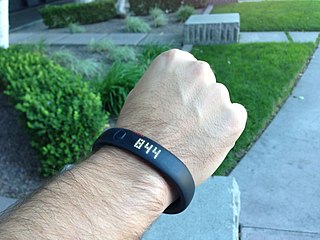
Quantified self refers both to the cultural phenomenon of self-tracking with technology and to a community of users and makers of self-tracking tools who share an interest in "self-knowledge through numbers". Quantified self practices overlap with the practice of lifelogging and other trends that incorporate technology and data acquisition into daily life, often with the goal of improving physical, mental, and emotional performance. The widespread adoption in recent years of wearable fitness and sleep trackers such as the Fitbit or the Apple Watch, combined with the increased presence of Internet of things in healthcare and in exercise equipment, have made self-tracking accessible to a large segment of the population.
Withings is a French consumer electronics company headquartered in Issy-les-Moulineaux, France. It also has offices in Boston, Massachusetts, USA, and Hong Kong, and distributes its products worldwide. Withings is known for design and innovation in connected devices, such as the first Wi-Fi scale on the market, an FDA-cleared blood pressure monitor, a smart sleep system, and a line of automatic activity tracking watches. It also provides B2B services for healthcare providers and researchers.

The Nike+ FuelBand was an activity tracker worn on the wrist and compatible with iPhone, iPad, or Android devices.
Digital health is a discipline that includes digital care programs, technologies with health, healthcare, living, and society to enhance the efficiency of healthcare delivery and to make medicine more personalized and precise. It uses information and communication technologies to facilitate understanding of health problems and challenges faced by people receiving medical treatment and social prescribing in more personalised and precise ways. The definitions of digital health and its remits overlap in many ways with those of health and medical informatics.
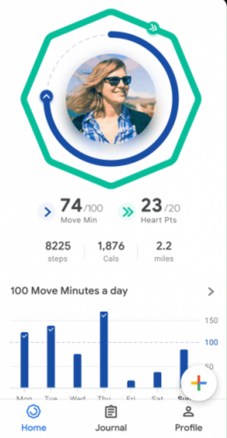
Google Fit is a health-tracking platform developed by Google for the Android operating system, Wear OS, and iOS. It is a single set of APIs that blends data from multiple apps and devices. Google Fit uses sensors in a user's activity tracker or mobile device to record physical fitness activities, which are measured against the user's fitness goals to provide a comprehensive view of their fitness.

The Xiaomi Mi Band is a wearable activity tracker produced by Xiaomi, unveiled during a Xiaomi launch event on 22 July 2014. This article is mainly about the original Mi Band; later versions have separate articles.
Digital phenotyping is a multidisciplinary field of science, first defined in a May 2016 paper in JMIR Mental Health authored by John Torous, Mathew V Kiang, Jeanette Lorme, and Jukka-Pekka Onnela as the "moment-by-moment quantification of the individual-level human phenotype in situ using data from personal digital devices." The data can be divided into two subgroups, called active data and passive data, where the former refers to data that requires active input from the users to be generated, whereas passive data, such as sensor data and phone usage patterns, are collected without requiring any active participation from the user.

A pulse watch, also known as a pulsometer or pulsograph, is an individual monitoring and measuring device with the ability to measure heart or pulse rate. Detection can occur in real time or can be saved and stored for later review. The pulse watch measures electrocardiography data while the user is performing tasks, whether it be simple daily tasks or intense physical activity. The pulse watch functions without the use of wires and multiple sensors. This makes it useful in health and medical settings where wires and sensors may be an inconvenience. Use of the device is also common in sport and exercise environments where individuals are required to measure and monitor their biometric data.

Sleep tracking is the process of monitoring a person's sleep, most commonly through measuring inactivity and movement. A device that tracks a person's sleep is called a sleep tracker. Sleep tracking may be beneficial in diagnosing sleep disorders. As sleep abnormalities are also symptoms of mental illness or relapsing psychotic disorders, it may also be beneficial in diagnosing mental disorders and psychotic disorders as well.
WHOOP is an American wearable technology company headquartered in Boston, Massachusetts. Its principal product is a fitness tracker that measures strain, recovery, and sleep. The device is best known for its use by athletes. The device is often used to keep track of overall health and even detection of illness.



